Bodhipaksa's Blog, page 15
January 11, 2014
Snow, ice, rain, mist

Earlier today on the river behind my house.
Related posts:
Leaves in ice
More leaves in ice
Toronto looks dystopian in the rain…
Related posts brought to you by Yet Another Related Posts Plugin.

Do Buddhists pray?
 Do Buddhists pray? It certainly looks like it sometimes.
Do Buddhists pray? It certainly looks like it sometimes.
Since Buddhism has no creator God you might assume that the Buddhist tradition has no room for prayer. The Buddha wasn’t a God. So would be the point of praying to him, or of praying at all?
Some forms of Buddhist practice that look like prayer don’t in fact involve the Buddha or any other enlightened figure. When Buddhists are cultivating lovingkindness and they’re repeating phrases like “May all beings be well; May all beings be happy,” they’re not invoking any kind of outside agency. What they’re doing is strengthening their own desire to see beings flourish and be free from suffering. By repeating the thought, and the intention, “May all beings be well; May all beings be happy,” they’re exercising and strengthening the faculty of kindness. So while this may resemble prayer, there isn’t really any petition (asking a deity for benefits) going on.
But depending on what kind of Buddhism you’re looking at, you’ll also see practitioners asking to be reborn in a Pure Land paradise after death, or using mantras to call repetitively on the name of a Buddha or Bodhisattva figure, or even asking one of them for a favor, or giving thanks for a blessing. And Tibetan Buddhism uses prayer flags and prayer wheels. What are all those about?
When Pure Land Buddhists call upon the saving grace of Amida Buddha in the hope of being reborn in his paradise after death, they’re doing something that to all intents and purposes is a form of prayer. For example here’s one Pure Land prayer: “I single-mindedly take refuge in Amit?bha Buddha in the World of Ultimate Bliss. Illuminate me with Your pure light and draw me in with Your loving, kind vows! Thinking only of You, I now call the name of the Tath?gata. For the sake of the Bodhi Way, I supplicate to be reborn in Your Pure Land.”
This isn’t the form of Buddhism I practice, and it doesn’t particularly appeal to me, but it’s not something I want to dismiss or be condescending about, Although it’s tempting for westerners to see these beliefs and practices as superstitious or naive, there is in fact a well-developed “theology” based around Pure Land practice, and it’s based on meditations that the Buddha himself encouraged: namely, Buddh?nusati, or “Recollection of the Buddha.” In Buddh?nusati we reflect on the qualities of the Buddha, and in doing so we develop an affinity with those qualities, and with enlightenment. And so Buddh?nusati helps us move toward becoming enlightened ourselves.
Reciting mantras is a very similar practice. When you hear a Buddhist reciting Om Manipadme Hum, what they’re actually doing is repeating the name of the Bodhisattva of compassion, Avalokiteshvara. One of this figure’s other names was Manipadma (The Lotus-Jewel One). This kind of mantra practice can be very effective even if you don’t believe Avalokiteshvara exists. Mantra works to a large extent by giving the mind a rest from the incessant angry, grasping, and anxious thoughts that plague us in our daily lives. When you’re reciting a mantra you just aren’t able to keep up a negative inner monologue the way you normally might. And again the mantra is a form of Buddh?nusati, and can help us to call to mind the qualities of a compassionate presence, and help those qualities manifest in our own minds.
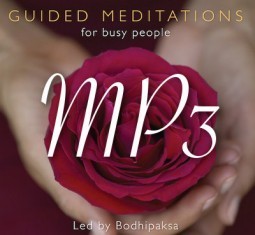 If you like my articles and want to support the work I do, please click here to check out my books, guided meditation CDs, and MP3s. Or you can make a donation.But it’s clear from Tibetan teachings on devotional practice that the Buddhas and Bodhisattvas are not separate from the nature of our own minds. It’s only a slight simplification to say that when you pray to Avalokiteshvara, you are invoking the power of your own potential awakened mind.
If you like my articles and want to support the work I do, please click here to check out my books, guided meditation CDs, and MP3s. Or you can make a donation.But it’s clear from Tibetan teachings on devotional practice that the Buddhas and Bodhisattvas are not separate from the nature of our own minds. It’s only a slight simplification to say that when you pray to Avalokiteshvara, you are invoking the power of your own potential awakened mind.
Prayer flags and prayer wheels fall somewhere in between lovingkindness practice and mantra. In fact prayer flags and prayer wheels are really “mantra flags” and “mantra wheels,” for the most part, since mantras are prominent on both forms of device. Tibetans believe that as prayer flags flap in the wind, or as a prayer wheel is spun, the blessings of the mantras will spread out on the wind and have a beneficial effect on all beings. Prayer flags and prayer wheels are a kind of “prayer technology.”
It’s hard to say how many westerners believe that prayer flags and prayer wheels work in this way. My guess is that only a small percentage does, and that for most of us prayer flags are a form of spiritual decoration, with mostly symbolic value.
With these various forms of practice going on within Buddhism, it would be hard to claim that there is no prayer in Buddhism. It is possible to point to differences between Buddhist prayer and the prayer of the mainstream theistic traditions, but the similarities are much stronger than the differences.
Nevertheless, sometimes people feel the need to pray, even though prayer strikes them as being a bit silly. My own teacher, when asked about this, advised, “If you feel like praying, then pray, and worry about the theology afterwards.” That’s wise advice.
Related posts:
Buddhists and violence
Buddhists and violence
Violent Buddhists and the “No True Scotsman” fallacy
Related posts brought to you by Yet Another Related Posts Plugin.

January 9, 2014
Like something from another planet…
Reshared post from +Laughing Squid
Countless Ice Balls Floating on the Shores of Lake Michigan?

Countless Ice Balls Floating on the Shores of Lake Michigan
Countless ice balls crowd the shoreline of Lake Michigan in Glen Arbor, Michigan in this short video uploaded to YouTube earlier this week by Bob Smitka. The ice balls are created when the lake coo…
Related posts:
A lake on Mars
Oh, yeah, baby!
Related posts brought to you by Yet Another Related Posts Plugin.

Oh, yeah, baby!
Science made fun.
Reshared post from +Laughing Squid
People Running and Dancing on a 2,100-Gallon Non-Newtonian Fluid Pool of Cornstarch and Water ?

People Running and Dancing on a 2,100-Gallon Non-Newtonian Fluid Pool of Cornstarch and Water
People run, dance, and bike across a 2,100-gallon pool of “oobleck,” a non-Newtonian fluid of corn starch and water, in this video shot in Kuala Lumpur by film company KIX. The event was sponsored …
This post has been reshared 1 times on Google+
View this post on Google+
Related posts:
Even better than Amazon drone delivery
Funny!
Free Market Jesus speaks…
Related posts brought to you by Yet Another Related Posts Plugin.

January 7, 2014
How beautiful it is to stay silent when someone expects you to be enraged
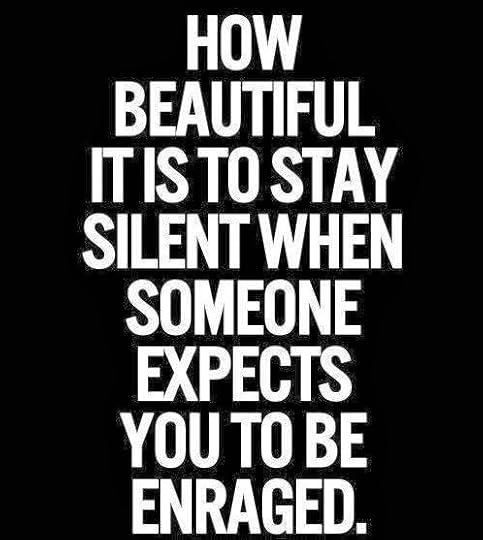
I was struck by the similarity between the quote in the graphic above and something the Buddha’s recorded as having said:
Whoever doesn’t flare up at someone who’s angry wins a battle hard to win.
I was a bit surprised, though, to see a comment attached to the graphic:
I love this one: it usually irks the attacker even more.
Remaining silent in order to irk someone doesn’t strike me as being a very noble motive!
The best reason for being silent instead of getting into an argument is simply to avoid unnecessary conflict so that there’s less suffering. The other person might get mad in the short term, but in the long-term they’ll benefit because you’ve given them less to be resentful about. You might experience discomfort in the short term because part of you really wants to fight back, but in the long term you’ll have less to regret and your emotional state will be more peaceful.?
Taking pleasure in someone else getting angry is, from a Buddhist point of view, unskillful. It’s just a subtle form of aggression. Our desire should always be to reduce the amount of suffering our actions cause.
Related posts:
Judge Voids Illinois Law on Silent Time in Schools
Matt Killingsworth: Want to be happier? Stay in the moment
How meditation can help students to stay focused and improve their grades
Related posts brought to you by Yet Another Related Posts Plugin.

January 6, 2014
Six reasons to think good thoughts
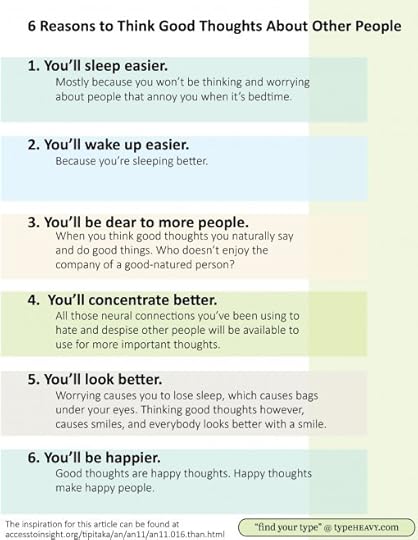
I really like this graphic that one of my Google+ friends, Shalone Cason, put together. Not only is it attractively presented, but it’s a very accessible interpretation of a traditional Buddhist teaching on the advantages of kindly thoughts.
You can find Shalone on Google+, and he also has a blog here.
Related posts:
“Nothing was ever so unfamiliar and startling to me as my own thoughts.” Henry David Thoreau
From reflections to random thoughts
Separating feelings and thoughts
Related posts brought to you by Yet Another Related Posts Plugin.

You think sitting still for 40 minutes in meditation can be uncomfortable?

You think sitting still for 40 minutes in meditation can be uncomfortable?
Reshared post from +Ashish T
Advertisement from Humanesociety.org?
Related posts:
Hit the ground sitting! Day 1 of our 100 Day Meditation Challenge
Hit the ground sitting! Day 2 of our 100 Day Meditation Challenge
Sitting without a sitter
Related posts brought to you by Yet Another Related Posts Plugin.

Separating feelings and thoughts
 One of the participants in our current 28 Day meditation challenge reported that she was experiencing stress because of a new job.
One of the participants in our current 28 Day meditation challenge reported that she was experiencing stress because of a new job.
New jobs can be very challenging and bring up a lot of self doubt. I remember that well.
She talked about “feelings of inadequacy and uselessness,” and I could instantly see a practice that would help her deal with the challenges of her new job. The practice is to distinguish between feelings and thoughts.
From the perspective of Buddhist psychology, inadequacy and uselessness are not feelings. Actual feelings that we might experience in a challenging new job include anxiety, or fear, or confusion. “I am inadequate” and “I am useless” are thoughts. They are interpretations based on our feelings. “Inadequacy” and “uselessness” are stories that we develop in order to make sense of the feelings of anxiety, confusion, etc. that we’re experiencing. Buddhism calls this prapañca, or “proliferation,”
We’re always trying to come up with stories that “explain” what’s going on in our lives. Stories like “I am inadequate” or “I am useless” serve to intensify our fear and confusion because we’ve “explained” our feelings by creating a story in which there’s something wrong with us that makes us incapable of dealing with the job. But these so-called explanations of why the job’s stressful just make us feel even worse.
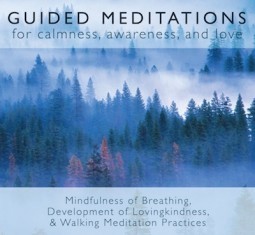 If you like my articles and want to support the work I do, please click here to check out my books, guided meditation CDs, and MP3s. Or you can make a donation.The practice here is to separate our feelings from our stories. So we can feel anxiety or confusion but not create stories around them. Or if stories arise automatically (“I can’t do this, I’m useless”) we can acknowledge them and recognize that they’re just stories, and not facts. We let go of the stories, and just return our attention to our present-moment experience.
If you like my articles and want to support the work I do, please click here to check out my books, guided meditation CDs, and MP3s. Or you can make a donation.The practice here is to separate our feelings from our stories. So we can feel anxiety or confusion but not create stories around them. Or if stories arise automatically (“I can’t do this, I’m useless”) we can acknowledge them and recognize that they’re just stories, and not facts. We let go of the stories, and just return our attention to our present-moment experience.
And having chosen to let go of our stories, we’re free to have other responses to our feelings, like regarding our discomfort with compassion. We can acknowledge our difficult feelings and accept them as a normal part of the learning process; if you’re stretching yourself to take on new capabilities, then of course you’re going to be confused at times, and of course you’re going to feel uncomfortable. We can share with other people how we’re feeling so that we don’t feel ashamed and don’t have to pretend that we understand when in fact we don’t. (Honesty is less stress-inducing than dishonesty, in most cases.)
Separating feelings and thoughts in this way is a key part of Buddhist practice, and it’s a very powerful tool.
Related posts:
“Nothing was ever so unfamiliar and startling to me as my own thoughts.” Henry David Thoreau
Breathe easy to combat anxiety: The mind tricks that can alleviate symptoms
Having a meditation toolkit
Related posts brought to you by Yet Another Related Posts Plugin.

January 3, 2014
We did it!
Reshared post from +Wildmind
Ladies and gentlemen, we did it! We've raised the $22,000 we needed in order to kick-start a new business manager at Wildmind, so that Bodhipaksa can have more time for writing and teaching. Mark, who has been donating much of his time, will be a full-time (and paid!) member of the team as from now.Thank you, thank you, thank you. ?
This post has been reshared 1 times on Google+
View this post on Google+
Related posts:
Almost $12,000 raised so far for the Free Bodhi project!
Free Bodhi Fund passes 50%
Related posts brought to you by Yet Another Related Posts Plugin.

Drop the “only”
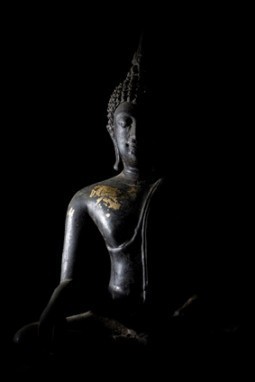 Our 28 Day Meditation Challenge, called Sit : Breathe : Love, started on January 1, with well over 1000 participants.
Our 28 Day Meditation Challenge, called Sit : Breathe : Love, started on January 1, with well over 1000 participants.
The aim is not just to try to meditate every day, but — far more importantly — to work on setting up the habit of daily meditation.
A few times people who are reporting on how they’re doing say they meditated, but it was “only” for 20 minutes or “only” for 15 minutes. I’ve said similar things myself.
But that word “only” bothers me. Using the word “only” is a great way of taking something you’ve done that’s good and making yourself feeling bad about it.? Compare “I exercised three days this week” and “I only exercised three days this week.” Or “I gave $10 to charity” and “I only gave $10 to charity.”
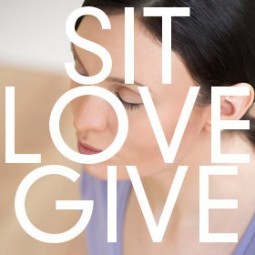 If you benefit from my work, please consider supporting Wildmind. Click here to make a one-time or recurring donation.You see how without the word “only” there’s a simple statement of fact, but it’s a statement that you can feel pleased about. And well you should. Exercising three times in a week (or even one time in a week) is great! Giving $10 to charity is great! And yes, meditating for 20 minutes or 15 minutes is great.
If you benefit from my work, please consider supporting Wildmind. Click here to make a one-time or recurring donation.You see how without the word “only” there’s a simple statement of fact, but it’s a statement that you can feel pleased about. And well you should. Exercising three times in a week (or even one time in a week) is great! Giving $10 to charity is great! And yes, meditating for 20 minutes or 15 minutes is great.
Add the word “only” and you feel bad, as if you’d done something wrong. It’s as if it’s bad to exercise, or to give money to charity, or to meditate. And if you feel bad about doing these things, how likely are you to want to continue with them?
When we’re saying we “only” did such-and-such an amount of meditation, we’re implicitly saying that there’s some amount (more than we did) that’s acceptable. And of course we didn’t reach that acceptable level.
Well, sure, meditating for 30 minutes, all other things being equal, is better than meditating for 15 minutes. But if we’re doing 30 minutes of meditation instead of 15 minutes, we’re not going from “bad” to good” but from “good” to better.”
Those 15 minutes (if that’s what you did) are way better than doing no meditation. And that’s what we need to remember. Any amount of meditation is a lot better than no meditation. So compare what you did with that, rather than some mythical amount of meditation that you didn’t do.
So I’d suggest that you watch out for that “only” and instead rejoice. Rejoice that you meditate at all. You’ll be far more likely to establish a solid meditation practice if you rejoice in doing 10 minutes than if you castigate yourself for only doing 20.
Related posts:
What animal trainers can teach you about establishing a daily meditation practice
Hit the ground sitting! Day 2 of our 100 Day Meditation Challenge
Hit the ground sitting! Day 6 of our 100 Day Meditation Challenge
Related posts brought to you by Yet Another Related Posts Plugin.




